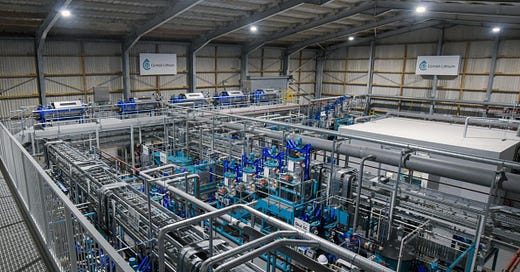A UK Company Targets China’s Dominance of Underused Lithium Ore
This news from Cornish Lithium is very exciting, and the potential for other projects in the UK and Europe—where there are viable lepidolite deposits—makes it even more so.
Lepidolite is a hard rock like spodumene, but instead of being a silicate, it’s a mica and doesn’t require the high-temperature calcination that spodumene does. However, it typically needs to be roasted with sulfates such as potassium sulfate or sodium sulfate, and there are reports that the waste-to-metal ratio can be as high as 200:1. This is why lepidolite is primarily processed in China, where the government subsidizes it to help meet precursor production demand.
Those familiar with how lithium is extracted from sedimentary ore should recognize the process they’ll be using. It’s essentially the same—after beneficiation and concentration, sulfuric acid is used to leach the ore at temperatures between 90°C and 120°C, producing a pregnant leach solution composed of lithium sulfate and other dissolved elements. As with sedimentary ores, the impurities are precipitated out in stages while the lithium sulfate is concentrated and ultimately converted into a lithium precursor.
The main difference is that with lepidolite, aluminum and iron are the primary impurities to manage, whereas with sedimentary ores it’s typically magnesium and calcium. Theoretically, the waste-to-metal ratio drops to around 10:1, with the main waste stream being fluoride-containing liquor, which must be treated before disposal. Fluoride compounds are toxic and can contaminate water supplies, posing risks to human health and aquatic life if not properly managed. Other byproducts can often be neutralized or regenerated like the sulfuric acid, which can then be reused, with solid residues—usually hydroxides or sulfates—potentially recoverable for sale.
This waste-to-metal ratio should not be confused with rock-to-ore ratios. Due to lepidolite’s lower lithium oxide concentration compared to spodumene, the amount of rock that must be mined and processed to produce one unit of ore is higher. Typical spodumene rock-to-ore ratios range from about 300:1 to 600:1, meaning 300 to 600 units of rock are moved to produce one unit of ore. This means that while the waste stream from processing will be lower, the volume of rock moved and processed in lepidolite projects can be higher than in spodumene projects, which could present environmental challenges during permitting.
Cornish Lithium is aiming to produce lithium from two sources: geothermal brines and lepidolite. This is ambitious, considering the only other companies seriously attempting to diversify their feedstock with a realistic chance of success are Rio Tinto and Albemarle—two dominant players in the lithium industry.
This acquisition from Lepidico gives Cornish Lithium sole rights to the intellectual property and patents related to the lithium extraction which will be deployed at their Trelavour Hard Rock Project. This technology has been under pilot testing since 2021 and will be licensed globally under Cornish Lithium’s brand, with the possibility of it being licensed and used worldwide.
I look forward to seeing progress reports from Cornish Lithium.
DISCLAIMER: This article should not be construed as an offering of investment advice, nor should any statements (by the author or by other persons and/or entities that the author has included) in this article be taken as investment advice or recommendations of any investment strategy. The information in this article is for educational purposes only. The author did not receive compensation from any of the companies mentioned to be included in the article.




